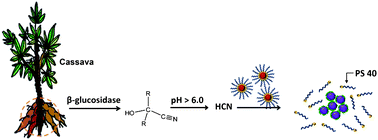Using polysorbate 40-stabilized gold nanoparticles in colorimetric assays of hydrogen cyanide in cyanogenic glycoside-containing plants†
Abstract
This study presents a convenient and homogeneous method for the selective detection of

* Corresponding authors
a
Department of Chemistry, National Sun Yat-sen University, Kaohsiung, Taiwan
E-mail:
tsengwl@mail.nsysu.edu.tw
Fax: +886-7-3684046
This study presents a convenient and homogeneous method for the selective detection of

 Please wait while we load your content...
Something went wrong. Try again?
Please wait while we load your content...
Something went wrong. Try again?
C. Liu and W. Tseng, Anal. Methods, 2012, 4, 2537 DOI: 10.1039/C2AY25291K
To request permission to reproduce material from this article, please go to the Copyright Clearance Center request page.
If you are an author contributing to an RSC publication, you do not need to request permission provided correct acknowledgement is given.
If you are the author of this article, you do not need to request permission to reproduce figures and diagrams provided correct acknowledgement is given. If you want to reproduce the whole article in a third-party publication (excluding your thesis/dissertation for which permission is not required) please go to the Copyright Clearance Center request page.
Read more about how to correctly acknowledge RSC content.
 Fetching data from CrossRef.
Fetching data from CrossRef.
This may take some time to load.
Loading related content
